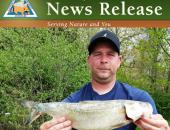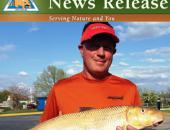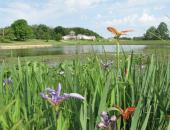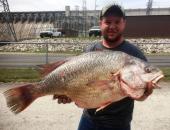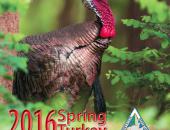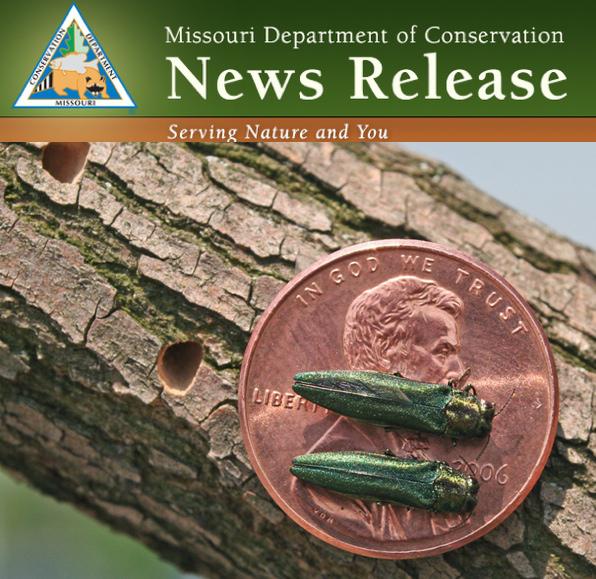
Missouri - Foresters with the Missouri Department of Conservation (MDC) urge people not to move firewood and ash logs to avoid the further spread of invasive Emerald Ash Borer (EAB) insects. Native to Asia, these bugs are destroying ash trees wherever they are, ruining millions of dollars in forest products and blemishing Missouri’s forests as they leave behind skeletons of dead ash trees. An MDC EAB distribution map was updated this week marking all the known Missouri counties with EAB infestations. Examination of ash trees on public land by a U.S. Department of Agriculture officer this spring has revealed additional EAB populations. The updated count of infestations in Missouri is 23 EAB positive counties with 16 of those in the southeast portion of the state.
According to Jennifer Behnken, MDC’s urban forester for Missouri’s southeast region, EAB is especially threatening to Missouri’s ash population because of a simple reason -- it doesn’t belong here.
“Our native borer insects kill only the severely weakened trees, the trees that need to be taken out anyway,” Behnken explained. “The EAB isn’t native to our area and it isn’t so picky. It kills healthy ash trees, so it’s devastating to our ash tree population.”
Behnken said there are few ways to control EAB in forests beyond trying to slow its spread. Many infestations start when people move infested ash wood into new areas. Missourians are encouraged to not move firewood, but rather obtain it near where it will be burned. A statewide EAB quarantine put in place by the U.S. and Missouri Departments of Agriculture in 2013 restricts the movement of ash nursery stock, any part of an ash tree, or firewood cut from any hardwood species into other states not known to have EAB.
“If people will stop moving ash trees, firewood or logs, that will help,” she said. “On their own, EAB can only move up to five miles a year, so that’s why moving firewood accelerates their movement tremendously.”
Also, Behnken said MDC encourages cities, counties and neighborhoods to work with a local forester to help manage ash tree populations.
Ash trees are popular in urban areas, like neighborhoods, because they have a hearty reputation and tolerate a variety of environments. They’re easily recognized and typically line urban streets to provide shade and improve the appearance and value of communities. However, they’re also a native tree to Missouri forests and the effects of EAB are becoming noticeable on the landscape.
“There are several reasons you might notice a dead tree in the middle of an otherwise healthy forest, but it’s becoming more often that you notice it’s an ash tree that’s fallen prey to EAB,” Behnken said.
With EAB, it’s the larvae that do the real damage. Adult beetles simply nibble on foliage, but the larvae feed on the inner bark of ash trees, which stops the tree’s ability to move water and nutrients and eventually kills it. All of Missouri’s native ash trees such as green, white, pumpkin and blue ash are vulnerable to EAB. Behnken said cultivars aren’t immune and EAB affects the trees at all stages, from saplings to fully mature.
“We ask that people watch for and report suspected EAB infestations in counties that aren’t yet known to have them,” Behnken said. “We’re working to understand how EAB spreads and we certainly appreciate help from people who notice damage to their ash trees.”
Symptoms of an EAB infestation include leaf die-off from the top of the tree, moving downward, excessive new branch growth (epicormic sprouting), bark splitting and woodpecker damage. To check an ash tree for EAB, look for a thin-bodied, emerald colored beetle that is less than a half inch long. Look for the “galleries” or long, squiggly tunnels EAB leave under the bark of ash trees and look for D-shaped exit holes about 1/8 inch in diameter left from adult EAB beetles emerging from an infested tree.
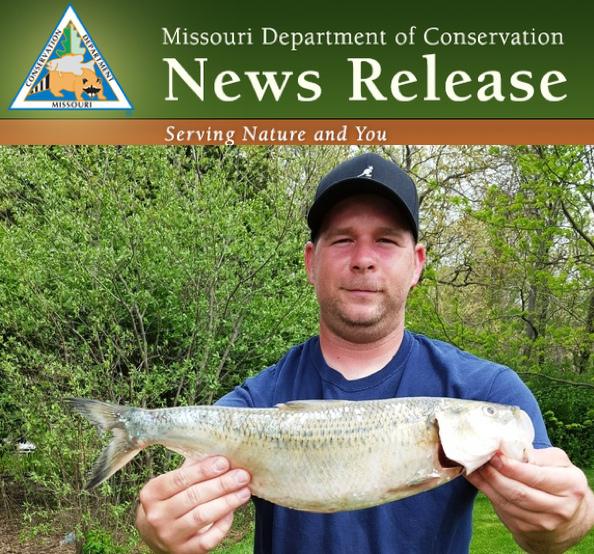
Missouri - The Missouri Department of Conservation (MDC) reports that Steve Wengler of St. Louis became the most recent record-breaking angler in Missouri when he hooked a skipjack herring on the Mississippi River using a rod and reel.
The new “pole and line” record skipjack herring caught by Wengler on April 17 weighed 2-pounds, 5-ounces. It broke the previous state-record of 1-pound, 14-ounces. Wengler was using two 1/8-ounce white and chartreuse jigs to catch the skipjack herring. MDC staff verified the record-weight fish using a certified scale in Defiance.
“The skipjack put up a pretty good fight, but I got it in as fast as I could because I didn’t want to lose the nice fish,” he said. “Once I got it in, I had an idea that I had caught the state record, but wasn’t sure until I put it on the scale.”
Anglers often catch skipjack herring to use for bait. The fish is boney, lacking in flavor, and is seldom used as food. But it fights spectacularly when hooked and can provide considerable sport on light tackle. The oil present in its flesh is said by fishermen to attract catfish. Skipjacks can usually be found in swift water below dams and around the ends of wing dikes.
“2016 is shaping up to be a big year for state record fish in Missouri,” MDC Fisheries Programs Specialist Andrew Branson said. “We have already had nine new records so far, which is more than an entire year sometimes. The mild weather we have had so far this year means more anglers are fishing, and catching big fish.”
Wengler added that he intentionally tried catching a state-record skipjack herring.
“I’m really thrilled to have caught a fish like this,” he said. “I’m really glad I was able to get my name in the record books. My plan now is to get back on the water and go after many more records.”
Missouri state-record fish are recognized in two categories: pole-and-line and alternative methods. Alternative methods include: throwlines, trotlines, limb lines, bank lines, jug lines, spearfishing, snagging, snaring, gigging, grabbing, archery, and atlatl.
James Lucas of O’Fallon recently snagged a state-record skipjack herring under the “alternative methods” category on the Mississippi River on April 8 that weighed 1 pound, 10-ounces with a length of 16 1/2 inches.
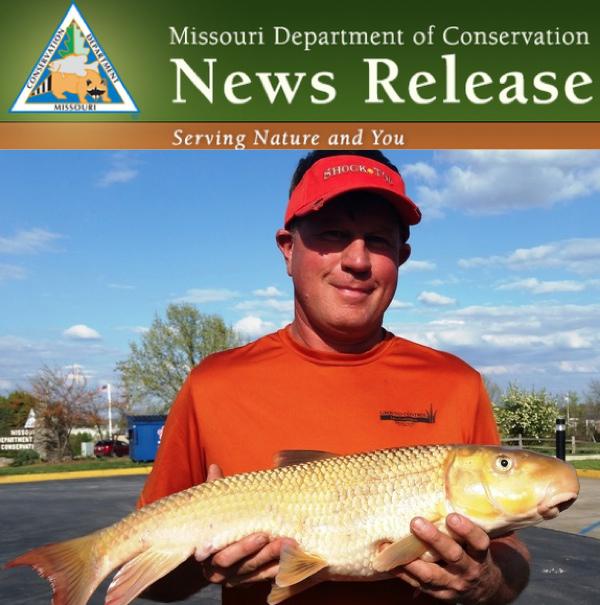
Missouri - The Missouri Department of Conservation (MDC) reports that Dan Schmitz of Jefferson City became the most recent record-breaking angler in Missouri when he hooked a river redhorse on Tavern Creek using a rod and reel.
The new “pole and line” record river redhorse caught by Schmitz on April 15 weighed 9-pounds, 13-ounces. It broke the previous state-record pole-and-line river redhorse of 9-pound, 10-ounces caught on the Osage River in 2006. Schmitz was using worms when he caught the fish. MDC staff verified the record-weight fish using a certified scale in Jefferson City.
“I fought the fish for about ten minutes before I got it to the bank,” said Schmitz. “I knew the fish was pretty big, but I didn’t know it was a state record until talking to MDC. I really can’t believe I caught a fish like this! I’m not a master angler. I’m just a hobby fisherman who loves to fish. I’m super excited to have the honor to be a state-record holder.”
River redhorse fish are a part of the sucker family. They are a moderately chubby, coarse-scaled fish with a dorsal fin containing 12 or 13 rays. These fish are can be found mostly throughout the Ozarks.
Schmitz’s fish also beats the current world record. While the river redhorse does get much larger, the International Game Fish Association (IGFA) only recognizes fish taken by pole and line.
“Larger river redhorses are usually taken by gigging and do not qualify for the IGFA world record,” MDC Fisheries Programs Specialist Andrew Branson said. “Conservation makes Missouri a great place to fish and this new unique record clearly shows why. This fish could be the largest river redhorse ever taken with a pole and line.”
Schmitz added it’s hard to believe he may be a world-record holder.
“I just can’t believe it! One day I’m fishing for fun and the next I could be a world-record holder,” he said. “I’m still in disbelief.”
Missouri state-record fish are recognized in two categories: pole-and-line and alternative methods. Alternative methods include: throwlines, trotlines, limb lines, bank lines, jug lines, spearfishing, snagging, snaring, gigging, grabbing, archery, and atlatl.

Missouri - The Missouri Department of Conservation (MDC) encourages motorists to give turtles crossing roads a brake. Turtles are struck by cars throughout warmer months, but are at special risk this time of year because they are on the move. Young males make up most of the travelers as they search for territories of their own and for female turtles. Comfort is also a factor. Like other reptiles, turtles are cold-blooded so basking on warm asphalt feels good on cool spring days.
MDC encourages motorists to slow down when they see a turtle in the road and check to be sure they can safely steer around it. If helping a turtle cross a road, keep human safety as the number-one concern. Check for traffic and move the turtle across the road in the direction it is traveling.
The three-toed box turtle is a species often seen crossing roads in Missouri. Primarily a woodland species, it is found everywhere but the extreme northern part of the state. The ornate box turtle is also a common traveler and is found in all but the southeastern corner of the state. It is more adapted to grasslands and is most common in western Missouri.
Shown in the photo is Elvis, a 3 toed-box turtle owned by Jessica Loflin.
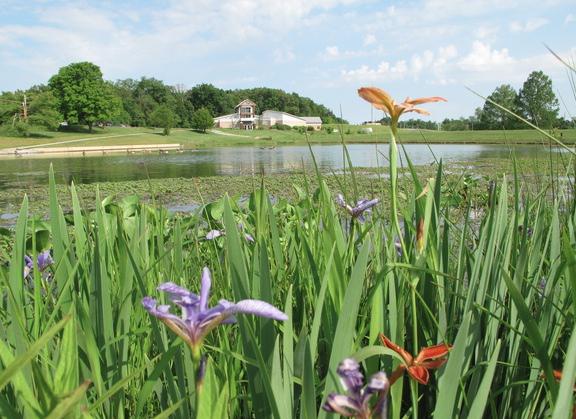
“Whether you do something on your own, like add native plants to your landscaping that day, or join us at the nature center for a formal program, Earth Day is a great time to pause and enjoy nature,” Turner said.
The nature center will celebrate Earth Day this Saturday, April 23, with A Southeast Earth Day. Events will be from 1 to 4 p.m. and will focus on the amazing plants, animals and habitats in diverse southeast Missouri habitats.
“Guests can walk our trail to find answers to trivia questions, make a recycled Earth Day craft, enjoy a nature film and many other activities that day,” Turner said.
Turner said there’s something for everyone at the nature center. Youth and adult groups are welcome to attend and no registration is needed for this event.
The Cape Girardeau Conservation Nature Center is located in Cape County Park North near the intersection of Kingshighway and Interstate 55.
